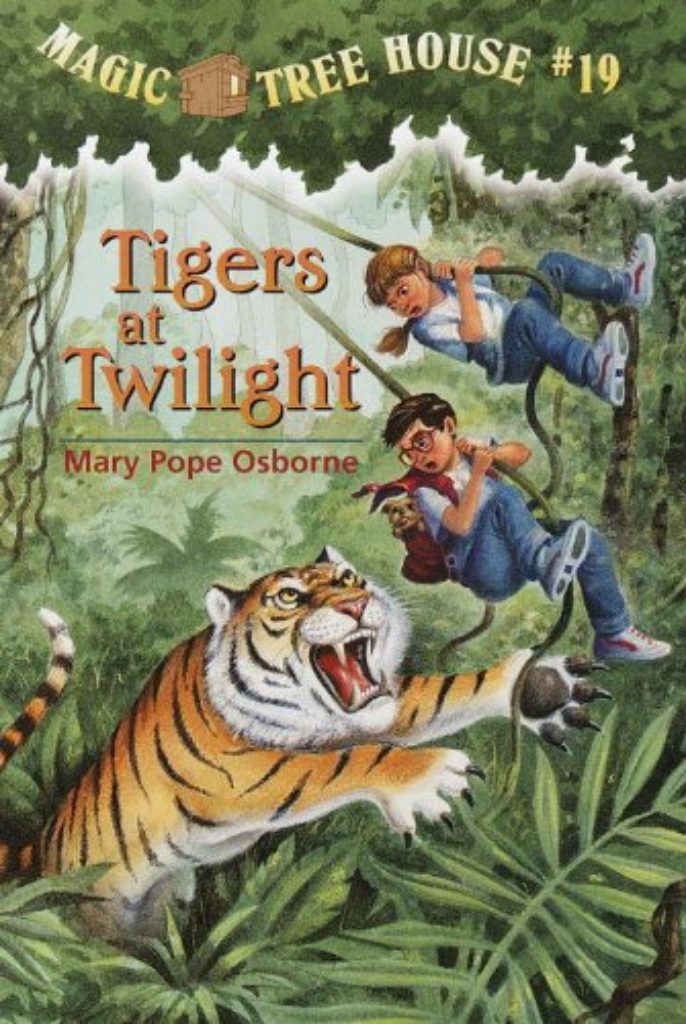This book has been reviewed by Focus on the Family’s marriage and parenting magazine. It is the 19th book in the “Magic Tree House” series.

This book has been reviewed by Focus on the Family’s marriage and parenting magazine. It is the 19th book in the “Magic Tree House” series.
Eight-year-old Jack and his younger sister, Annie, run into their friend Teddy, a dog under a spell. Teddy leads them to the magic tree house, where they find a note from Morgan Le Fay, the magical librarian who owns the tree house. The note reminds the kids that they must collect four gifts in order to lift the spell on Teddy. Jack finds a book and points to their next destination, India, and the tree house takes them to where they will find their third gift.
The tree house lands in a lush jungle, and two monkeys appear on the windowsill. Annie names them Kah and Ko, after the sounds they make. Kah and Ko lead Jack, Annie and Teddy through the forest. Jack reminds Annie that they must be cautious.
Soon they come across a tree with deep gouges in its bark. Jack looks in his book and identifies the gouges as tiger claw marks. Annie is unfazed by the possibility of a tiger nearby, so Jack continues reading facts about tigers to help her understand the danger. Suddenly, the forest animals sound upset and fearful. The children follow Kah and Ko up a tree to escape what they soon discover is a python. The monkeys show Jack and Annie how to use the vines to swing to safety. A tiger leaps out of the brush and swipes at the children in midswing, but they reach the next tree without a scratch.
A herd of elephants passes by the tree. Because of the book, they know that tigers don’t attack elephants, so Annie suggests that they ride one to a safer part of the jungle. They remain on an elephant’s back through the night.
The next morning, Jack and Annie find a tiger caught in a steel trap. Jack reads that tigers are endangered, so the children decide to free the tiger. They carefully release the tiger’s paw, and then they slowly back away. Even so, the tiger approaches the children, growling. Jack and Annie run for cover while Teddy faces down the tiger, barking until the threat leaves.
Kah and Ko lead Jack, Annie and Teddy down the river until they come across a blind hermit. The hermit explains that by saving the tiger, they couldn’t expect it to change its nature and be nice to them in gratitude. Freeing the tiger, he says, was still the right thing to do. He gives them a white lotus flower, their third gift, and points them in the direction of the tree house.
Back home, Jack wonders how Teddy saved them. He seems to be more than just a dog. He also wonders how a blind hermit could have known where the tree house was, and Annie reminds him that the hermit said he learned by listening to the forest.
None
Magic is a theme throughout the book. Teddy is under a spell, and Morgan Le Fey has magic powers. The hermit explains to the kids that he learns by listening to what’s around him, since he can’t see anything. He equates the sounds of the forest with a teacher and gives human qualities to nature. Also, the gift of the white lotus with its muddy roots is meant to symbolize how beautiful things sometimes need ugly things in order to live.
Through her note, Morgan Le Fay encourages the kids in their quest to find the gifts that will free Teddy. As the older brother, Jack always reminds Annie to be careful on their adventures. When the hermit tells Annie to bring him a lotus flower, she obeys without question.
None
None
Get free discussion questions for this book and others, at FocusOnTheFamily.com/discuss-books.
You can request a review of a title you can’t find at [email protected].
Book reviews cover the content, themes and worldviews of fiction books, not their literary merit, and equip parents to decide whether a book is appropriate for their children. The inclusion of a book’s review does not constitute an endorsement by Focus on the Family.